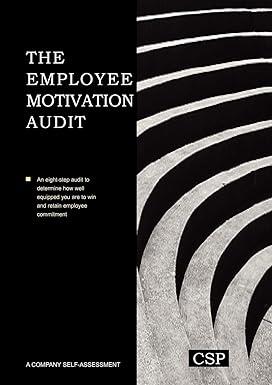Question
4. Joe and his sister Patty are considering investing $6,000 to start a used book business. They expect to receive cash inflows of $1,000 each
4. Joe and his sister Patty are considering investing $6,000 to start a used book business. They expect to receive cash inflows of $1,000 each year for the next four years from the business. At the end of the fourth year, they expect to be able to sell the business for $10,000 cash. What is the net present value of the book business investment if Joe and Patty want to earn at least a 12% return from it? (Ignore taxes)
a. $3,037 c. $3,397
b. $6,360 d. $2,904
5. Kern Co. is planning to invest in a two-year project that is expected to yield cash flows from operations of $50,000 in the first year and $80,000 in the second year. Kern requires a return of 14 percent on all investment projects. The maximum that Kern should invest in this project is: (Ignore taxes)
a. $130,000. c. $120,160.
b. $105,370. d. $161,000.
6. If the internal rate of return is equal to the minimum required rate of return used to compute the net present value of a proposed machine purchase, then the net present value will be:
a. positive. c. zero.
b. negative. d. unknown.
7. The Valentine Company has decided to buy a machine costing $14,750. Estimated cash savings from using the new machine amount to $4,500 per year. The machine will have no salvage value at the end of its useful life of five years. The machines internal rate of return is closest to:
a. 10%. c. 14%.
b. 12%. d. 16%.
8. A new machine costing $750,000 will yield cash savings of $250,000 each year for four years. In addition, it is anticipated that the new machine will increase productivity and that the company will experience an increase in contribution margin as a result. What annual dollar inflow from increased contribution margin would the company have to experience to make the machine an acceptable investment if the minimum desired rate of return is 18%?
a. $28,810.41 b. $62,500.00 c. $77,500.00 d. $39,687.14
9. The payback period of an investment is useful in determining its:
a. net present value.
b. overall profitability.
c. acceptability in terms of the length of time until the invested funds are free for use elsewhere.
10. Jacobs Co. is considering buying several specialized tools at a cost of $5,000. The new tools will save the company $1,500 in manufacturing costs each year and are expected to last 4 years. Assume salvage is $0 and the tax rate is 34%. Jacobs Co. uses MACRS 200% Declining Balance method to compute depreciation for income tax purposes. The 200% Declining Balance depreciation rates are: 33.33% in year 1, 44.45% in year 2, 14.81% in year 3, and 7.41% in year 4. Using a minimum desired after-tax rate of return of 12%, the net present value of the tool purchase would be: (include the effects of taxes)
a. $124.69 b. ($625.76) c. ($437.95) d. $836.47
11. Extra Credit (1 pt): Refer to #10 above. Assume salvage is $1,000 and that Jacobs uses the straight-line method to compute depreciation for tax purposes. For tax purposes, these tools will be depreciated over a 3-year life under the assumption they were purchased mid-way through the first year and that residual value is $0 (Hint: use depreciation rates of 1/6 in year 1, 1/3 in year 2, 1/3 in year 3, and 1/6 in year 4). Using a minimum desired after-tax rate of return of 10%, the net present value of the tool purchase would be: (include the effects of taxes)
a. ($379.28) b. $986.34 c. ($66.22) d. $125.72
Step by Step Solution
There are 3 Steps involved in it
Step: 1

Get Instant Access to Expert-Tailored Solutions
See step-by-step solutions with expert insights and AI powered tools for academic success
Step: 2

Step: 3

Ace Your Homework with AI
Get the answers you need in no time with our AI-driven, step-by-step assistance
Get Started


